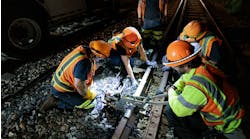NJ Transit deploys AquaTrack machines to clear leaf debris
New Jersey Transit is keeping its rails clear of leaf debris through the fall season with the use of two AquaTrack machines.
The AquaTrack equipment is a high-pressure power washing system that removes the oily residue left behind by fallen leaves on the tracks to prevent train delays caused by “slippery rail” conditions.
“The AquaTrack is just one example of how we continue to leverage technology to keep our operations running efficiently,” said New Jersey Department of Transportation Commissioner and NJ Transit Board Chair Diane Gutierrez-Scaccetti. “Our core mission is to move New Jersey safely and reliably and we are using every tool at our disposal to accomplish that.”
“As NJ Transit continues to improve our rail network’s on-time performance, AquaTrack units help maintain service reliability for our customers,” said NJ Transit President and CEO Kevin S. Corbett. “These two AquaTrack units are deployed strategically throughout our system to keep our tracks clean and our trains rolling throughout the fall season.”
The AquaTrack system has been in use by NJ Transit since October 2003. It consists of two 250-horsepower diesel-engine units mounted on a flat car with an operator control cab. Two pressure-pump units dispense water up to 20,000 pounds-per-square-inch directly to the top of the rail. The process uses 17 gallons of water per minute.
The original AquaTrack operated primarily on the M&E and Montclair-Boonton lines, which face challenges including the hilly areas around Glen Ridge and Summit stations, washing the rails twice a day Monday through Friday—once overnight and again during midday hours. On weekends, the Pascack Valley and Main/Bergen County lines are usually covered.
In 2016, NJ Transit unveiled its second AquaTrack unit, which allows the cleaning process to maintain a larger coverage area in helping to prevent delays caused by slippery rail.
Fallen leaves left on rail tracks can cause a condition known as “slippery rail” – a challenge facing all railroads in the Northeast and other parts of the world where deciduous trees are prevalent. The decaying leaves create an oily residue that coats the rails and cause poor traction. The decreased train speeds, in turn, create delays.
In addition to AquaTrack, NJ Transit trains are equipped to spray sand on the rails in front of their wheels to increase traction. NJ Transit also trims trees to help stem the amount of leaves on the tracks.


